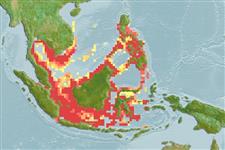>
Clupeiformes (Herrings) >
Engraulidae (Anchovies) > Engraulinae
Etymology: Stolephorus: Greek, stole, -es = garment + Greek, pherein = to carry (Ref. 45335).
More on author: Bleeker.
Environment: milieu / climate zone / depth range / distribution range
Écologie
marin; saumâtre; amphidrome (Ref. 51243); profondeur 0 - 50 m (Ref. 189). Tropical; 17°N - 11°S, 98°E - 127°E (Ref. 189)
Western Pacific: Gulf of Thailand and Java Sea. Indian Ocean records probably based on Stolephorus baganensis or Stolephorus insularis.
Taille / Poids / Âge
Maturity: Lm ? range ? - ? cm
Max length : 9.5 cm SL mâle / non sexé; (Ref. 189)
Épines dorsales (Total) : 0; Épines anales: 0; Rayons mous anaux: 17 - 18. Belly with 6 or 7 small needle-like pre-pelvic scutes; a small pre-dorsal spine and another spine on the pelvic scute. Maxilla pointed, reaching to or beyond hind border of pre-operculum, the latter concave, indented near maxilla tip. Anal fin short, with origin below about middle of dorsal fin base. A double pigment line on back both before and behind dorsal fin.
A schooling species found in coastal waters. Adults frequently visit the lower reaches of mangroves where neritic conditions are present (Ref. 43081). More specimens and data needed.
Life cycle and mating behavior
Maturities | Reproduction | Spawnings | Egg(s) | Fecundities | Larves
Wongratana, T., T.A. Munroe and M. Nizinski, 1999. Order Clupeiformes. Engraulidae. Anchovies. p. 1698-1753. In K.E. Carpenter and V.H. Niem (eds.) FAO species identification guide for fishery purposes. The living marine resources of the WCP. Vol. 3. Batoid fishes, chimaeras and bony fishes part 1 (Elopidae to Linophrynidae). FAO, Rome. (Ref. 9822)
Statut dans la liste rouge de l'IUCN (Ref. 130435)
Menace pour l'homme
Harmless
Utilisations par l'homme
Pêcheries: commercial
Outils
Articles particuliers
Télécharger en XML
Sources Internet
Estimates based on models
Preferred temperature (Ref.
123201): 28.2 - 29.1, mean 28.8 °C (based on 302 cells).
Phylogenetic diversity index (Ref.
82804): PD
50 = 0.5000 [Uniqueness, from 0.5 = low to 2.0 = high].
Bayesian length-weight: a=0.00537 (0.00262 - 0.01101), b=3.17 (2.99 - 3.35), in cm total length, based on LWR estimates for this species & (Sub)family-body (Ref.
93245).
Niveau trophique (Ref.
69278): 3.3 ±0.4 se; based on size and trophs of closest relatives
Résilience (Ref.
120179): Haut, temps minimum de doublement de population inférieur à 15 mois (K>1).
Fishing Vulnerability (Ref.
59153): Low vulnerability (10 of 100).
Nutrients (Ref.
124155): Calcium = 472 [141, 1,252] mg/100g; Iron = 2.49 [1.36, 4.42] mg/100g; Protein = 19.3 [17.5, 21.2] %; Omega3 = 0.478 [0.207, 1.122] g/100g; Selenium = 45.4 [19.8, 97.1] μg/100g; VitaminA = 38.5 [8.5, 162.7] μg/100g; Zinc = 2.68 [1.74, 3.99] mg/100g (wet weight); based on
nutrient studies.
